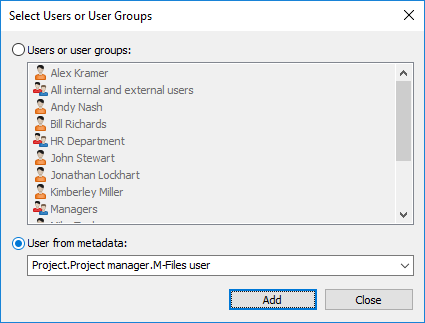Instead of just adding users or user groups to the permissions of an object, you can also add so-called pseudo-users, or users from metadata, as well.
You can specify pseudo-users directly for the object and use these automatic pseudo-users for automatic permissions and named access control lists. Pseudo-users that are specified via properties can also be used in workflows when you want to specify people for tasks, send a notification to users, or define permissions for different states.
You can specify pseudo-users via only those properties that are based on a Users or User groups value list.
Video: Dynamic Access Control Entries
Example: You can specify that the project manager for a certain project always has access to an object if this project is indicated in the object's metadata. Then the project manager information is automatically delivered to the object with the project and, on the basis of automatic permissions, the user is granted project manager access rights to the object. In case the project manager is changed, the project manager information can easily be changed for the project. This information is transferred to the documents or other objects, so updating their project manager information separately is not necessary.
You can also perform multilevel user definitions via properties. For example, you can define the project manager via the related project property (see the image below). This way, the project manager information is kept up to date constantly, as it is associated with the project instead of each separate document. You can specify access for these pseudo-users by object or utilize them when defining automatic permissions.

Select "User from metadata" when you want to specify pseudo-users.
You can specify automatic permissions and utilize the pseudo-user definitions in, for example, the "contract of employment" class, which grants specific rights automatically to, for instance, an employee's supervisor. In this case, the supervisor is automatically found with the employee information and the supervisor is granted the appropriate rights. If the employee's supervisor changes, these rights are automatically granted to the new supervisor.
For more information on automatic permissions, see Automatic Permissions.